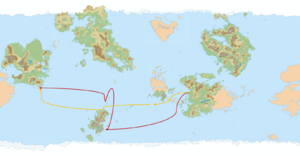Southern Route
The Southern Route, also commonly known as the South Alshar-Sarpedon sea route is a shipping route from the Corummese southeastern coast, through the Ocean of Cathay and on to the Kindreds Sea and Pelaxian and Acirian ports. The first recorded complete voyage of the route was made in 1615 by Gabo de Pogiano, an explorer and adventurer from the Carto-Pelaxian Commonwealth who started his trip on the port of (insert Pelaxian port) on the Kindreds Sea and came into contact with the Corummese Qian dynasty in Port Bondor, Zhijun. Impetus for developing alternate trade routes gained traction and support at the Qian court mainly as a way to evade the Burgoignesc monopoly on all Audonian sea routes. The route would become more profitable to traverse in the early 17th century after the Qian colonization of Stenza by the South Seas Trading Company. In the modern era the route continues to be an important lane for international marine shipping and several national navies operate throughout its whole length to provide security.

History
See Also: Pelaxian discovery of the sea route to Alshar
Background
Historically, sea exploration by Corummese dynasties was severely lacking in comparison to Levantine powers such as Burgundie. Most of Corummese trading with its neighbours was conducted through overland routes, rivers or by sea shipping that stuck close to the coastline. Burgundie's possession of islands controlling access to important waterways in Audonia such as Salarive and Antilles and its sometimes predatory attitudes, the dangers posed by Audonian pirates and high tariffs made trade through Burgoignesc controlled waters a fairly unappealing prospect. The discovery of Zhijun and later Stenza by an expedition commissioned by Emperor Yuanjian of the Qian dynasty opened the possibility of further lands yet to be discovered. Admiral Xi Haifong proceeded to conquer the Stenzan polynesian tribes and established the port of Xiwang there in 1613. The arrival in 1615 of Carto-Pelaxian explorer Gabo de Pogiano at Zhijun's Port Bondor confirmed to the Qian the existence of lands further east to trade with. Gabo de Pogiano established a rapport with the governor of Zhijun and was allowed to sail to Corumm alongside the Grog Fleet for an audience with imperial authorities.
Pending: Input from Pelaxia, Aciria on circumstances leading to seeking alternative trade routes
Establishment
Gabo de Pogiano's 1615 journey became an embassy after contact with the Corummese. After arriving in the port of Zong on the 10th of October, he had an audience with Digen Youdu, Viceroy of Ganshu; with whom he negotiated an agreement that allowed him to dock in Corummese ports and engage in trade, map out the surrounding seas and build a fort in the Tanhai coastal commandery. Pogiano in turn committed himself to on his return trip, guide a Qian squadron to the Kindreds Sea and the coast of Sarpedon. The ships that would join him on Zhijun were the Falun, the Gong and the Shen Yun; the first Corummese ships to ever make it to Sarpedon. Later contacts with Acirien representatives would lead to a similar agreement. The Qian would send goods such as sugarcane, barrels of slozo, pink salt, ebony wood and cinnamon and in return would receive (insert Sarpedonian products such as wine)
The outsourcing of colonial administration of the Stenza territory to the South Seas Trading Company and the expansion of its commercial activities by establishing bases in Port Bondor, Rakin (later Rakahanga) and Ambo led to the establishment of a quasi commercial monopoly on the western end of the Southern Route. As the company's wealth increased, it would outfit a fleet of warships of its own, nominally under Imperial control but in practice operating to protect company commercial interests. The Harmonious Flotilla Invincible began operating in 1758, when it fended off Bergendii corsairs off the coast of Freda Island.
Economic Impact
- Corumm:The impact of the establishment of the southern route was enormous in both economic and cultural terms for the Corummese. The flow of trade goods greatly enrichened the Qian state, fwith the treasury benefiting from extra taxes and tariffs, including a tax on all precious metals, fees for providing naval protection to merchant ships, docking, warehouse uses and clerical services. In addition there were cultural and technological exchanges, with several sarpedonian scholars taking up employment with the Corummese. One such case was mathematician and astronomer Justo Barbajan, who worked at the Qian court as Director of the Imperial Observatory. The first Christian preachers arrived by boat in 1623, with one of them eventually founding what would become the Democratic Christian Church of Corumm and the East.
- Pelaxia:
- Aciria:
- Stenza:
Add economic impact here separated by nations